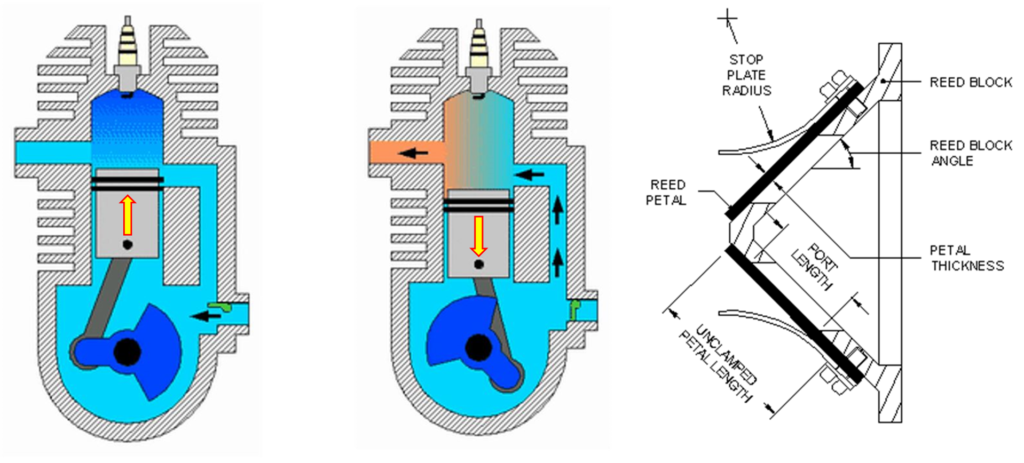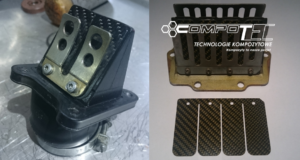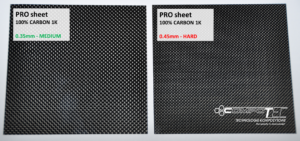INFORMATION: To see our offer of ready-to-use carbon fiber reed valve petals please check out our eBay listing (click here). If petals for your vehicle are not yet listed, please contact us – we may have them available. If not, we’ll be happy to make them for you within couple days. We ship worldwide!
In a two stroke engine when the piston moves upwards in suction-compression stroke, sudden pressure drop occurs in the chamber below the piston (crankcase). At this moment fresh air-fuel mixture is sucked from the carburetor to the crankcase. Next, when the piston moves downwards in work-exhaust stroke, this fresh mixture is pushed upwards to reload the combustion chamber. In older, less powerful generations of two stroke engines part of the fresh mixture being pushed out from the crankcase was moving back to the carburetor. Nowadays, a one way valve is used between the crankcase and the carburetor. This valve is called a reed valve and is shown on Pic. 1. Reed valve allows the mixture to move in only one direction – from the carburetor to the crankcase. It prevents the mixture from moving back to the carburetor. In the effect reed valve improves reloading of the combustion chamber with fresh air-fuel mixture. This improves power output of modern two stroke engines.

Pic. 1. To the left: suction-compression stroke – reed valve (green) is open. To the right: work-exhaust stroke – reed valve is closed. (Source of all the graphics above: Wikipedia article)
Reed valve design is simple (see Pic. 2): a valve comprises of the case/support to which reed petals (also called “reeds”) are attached. In most, but not all, applications reed petal movement limiter is also used. Due to underpressure created in the crankcase during suction-compression stroke, reeds lift-off allowing fresh air-fuel mixture to pass through. Next, in work-exhaust stroke, reeds close due to its’ own resiliency and overpressure occurring in the crankcase. In the effect, since the mixture cannot move back to the carburetor, more of it is loaded to the combustion chamber.

Pic. 2. Gas Gas 125 (left) and Kawasaki KX250 (right) motorcycle reed valves with carbon reeds manufactured by CompoTec
The cycle described above repeats proportionally to the engine speed usually given in Rotations Per Minute or RPM. This means that reeds can open & close thousands of times per minute. Each cycle, the total of which must be counted in millions, uses a bit of reed petal „life” since pretty much every material has limited fatigue capability.
Typical symptom of reed valve petals damage and/or wear is difficulty to start the engine and uneven/non-smooth working manner. Reeds should be occasionally checked for proper sealing and lack of chipped material or cracks. One of the ways to check for proper sealing is to direct reed valve cone (with reeds outside) towards a strong light source. If no light can be seen from the inside of reed vale assembly this means that sealing is very good. However, when straight, non-pre-curved reeds are used, small gaps up to approx. 0.2mm (0.008in) are usually not a problem. The reason for this is that crankcase pressure fluctuations from underpressure to overpressure make reeds to open as well as to close. Reed petals should always be replaced if material is chipped, usually at the edges, or cracks are visible.
Early reed petals were manufactured from stainless steel sheets. Stainless steel reeds are inexpensive, very durable and have good resiliency. Their main disadvantage is that petal separation usually results in engine damage. Other disadvantage, probably less important for regular user, is reed petal’s mass. The lighter the reed petal and the lower the interia, the better it can “follow” the engine RPM and improve power output. This is why in motorsport composite reed petals were introduced. Initially these were glass fiber based. Later, carbon fiber was used as it offers even better parameters – lower mass and higher stiffness at same thickness. Composite, glass of carbon fiber based, reeds are not that durable as metal ones. However, their significant advantage is that in case of reed petal failure liberated piece will usually not make any damage to the engine. Epoxy based composite is soft in comparison to metal engine parts and is usually “grinded out”.
Optimal reed valve petal thickness and stiffness is usually selected by experience and/or some trial-and-error. Both these parameters, which correspond to each other, impact performance of a two stroke engine. Thin & more flexible reeds improve acceleration and performance at lower RPMs. Thicker & more stiff reeds improve power output at high RPMs. Typical reed petal thickness available at the market ranges from 0.25mm (0.010in) to about 0.5mm (0.020). The most popular and frequently offered are carbon fiber reeds, but glass fiber and sometimes aramid (Kevlar®) fiber based reeds are also available.
Offer of carbon fiber & epoxy based reed valve petals by CompoTec
In the result of intense research and technology development, CompoTec owns its’ unique & proprietary know-how to manufacture double smooth (gloss or matte) carbon fiber, glass fiber and aramid fiber reinforced composite sheets starting from the thickness of 0.25mm (0.010in). Carbon fiber based, 0.25-0.5mm (0.010-0.020in) thick, composite sheets we manufacture are dedicated to cutting high quality reed petals. Offered sheets have high durability, optimum fiber to reinforcement ratio and narrow thickness tolerance range. High temperature epoxy resin system we use has catalogue temperature capability of 180degC (356degF). We use full heat treat cure cycle to ensure the best parameters.
All our carbon reeds are intensely tested, including testing by Polish trial and motocross competitors. These are also successfully used on daily basis by hundreds of customers. Based on this cumulative experience and feedback being received we are certain about quality and performance of our product!

Pic. 3. CompoTec 100x100mm (3.93×3.93in) PRO 1K carbon sheets dedicated to self-cutting of reed valve petals: 0.35mm (0.0137in) – medium and 0.45mm (0.0177in) – hard.
We are looking forward to cooperation with distributors, shops, two stroke engine service shops as well as individual customers. We offer high quality, carbon fiber & epoxy based material dedicated to self-cutting of any reed valve petals. We can also develop a material adjusted to particular needs or requirements.
Recommendations for selecting, cutting and maintaining reed valve sheets/petals:
- Reeds thickness is proportional to engine size and power output. The bigger the engine, the thicker reeds should be used.
- Too thin reeds are susceptible to premature damage. For engines above 200ccm we suggest using 0.45mm (0.0177in) thick sheets from our range.
- Our customers have good experience with using this sheet thickness for reed petals to be used in VFORCE2, VFORCE3 and VFORCE4* reed valve series.
- Reed petals can be cut manually using i.e. scissors and/or Dremel tool, but best effects and durability will be achieved by cutting them on CNC router. After cutting smoothly blend all edges with i.e. sand paper to avoid fraying/chipping.
- All reed valve petals wear away and have limited life. It’s advised to check the condition of your reeds every 15-20 engine work hours and always if problems with engine start and/or smooth running exist.
CompoTec PRO carbon reed sheets specification:
- Multi-layer, flat sheet made out of 100% 1K woven carbon fiber (increases reeds stiffness & durability).
- High temperature epoxy resin system – catalog capability up to 180degC.
- Minimum sheet size 100x100mm (3.93×3.93in).
- Available nominal thickness: 0.35mm & 0.45mm (0.0137in & 0.0177in).
- Thickness tolerance range +/-0.05mm (0.002in).
* VFORCE® reed valve series is a trade mark of Moto Tassinari company. All other brands and/or names belong to their respective owners and are used only to show compatibility.


